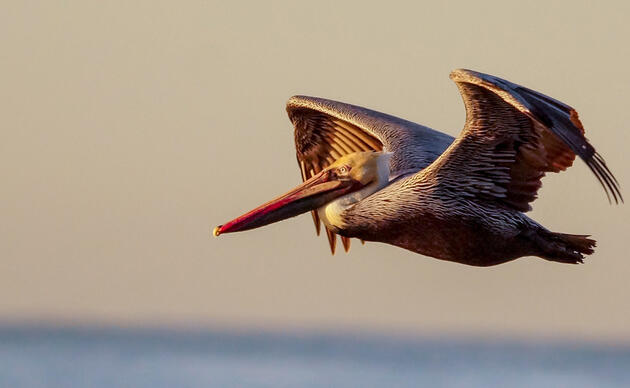A cool clear day, slight wind coming from the west, the distant tapping of a Red-bellied Woodpecker, and the smell of diesel and gasoline torches. My early childhood education on fire came from a large animated bear wearing a hat, and he said forest fire prevention begins with me. Since I wasn’t allowed to play with matches or smoke cigarettes, I was confident that I could obey the bear on TV and prevent forest fires. Yet, on this cold January morning, I intentionally started a forest fire, and it was just as fun as I had imagined.
I watched and helped as a team of six fire crew members walked through a pine forest dripping fire from torches, lighting lines of flaming organic matter around grass-stage longleaf pine seedlings, underneath towering loblolly pines. Starting on two sides of a predetermined plot of forest, the fire was strategically ignited to burn in a prescribed manner to restore this mixed pine forest into a longleaf pine savannah, a habitat type that was once a dominant feature of South Carolina’s landscape.
With the arrival of European settlers and their hunger for timber products, slow-to-mature longleaf pine trees were heavily harvested. These slow growing trees make up a unique ecosystem that supports a variety of species, most notably the Red-cockaded Woodpecker and the Gopher Tortoise. With the heavy logging of these trees, many of the species that thrived in this unique ecosystem declined to an endangered status.
Fire is a natural part of the landscape, and it is an essential part of maintaining vegetation in a way that is favorable to numerous species. Thus, to restore longleaf pine savannah habitat, forest managers must set it on fire every few years, mimicking the way lightening tends to spark fires in the wild, and burning frequently enough to maintain the level of vegetation present.
Another species that burning at McAlhany will benefit is the endangered American chaffseed, a perennial herb in the broomrape family native to the southeastern United States, and one of those that relies on fire to thrive. There is a newly planted plot of American chaffseed in the stand we were burning that day.
Before we started, I told Mark Musselman, land manager for Audubon South Carolina, that I was excited to be a part of my first controlled burn.
Mark laughed, and replied matter-of-factly, “There’s no controlling the fire once you set it. But we set it in a prescribed way, so it will burn the way you want it to.”
It was a surprising and enlightening perspective—and an important reminder that prescribed or not, fire is powerful and must be treated with great responsibility and respect.
Joe Cockrell, volunteer manager for Charleston Audubon's McAlhany Nature Preserve in Branchville, near St. George, has been invaluable to keeping McAlhany running in top condition. From planting longleaf seedlings and fixing the plumbing, to laying flagstone on the cabin fireplace and burning longleaf stands, Joe is a jack of all trades and knows the property better than anyone. With weather instruments and maps in hand, he and Mark reviewed the strategy for the day’s burn.
“If there’s no wind, the fire won’t move and won’t burn,” Mark explained, highlighting the important role that wind direction and speed and relative humidity play in any burn. “If there’s too much wind, the fire will jump the breaks and start spot fires and burn places you don’t want to burn. The relative humidity will also determine how fast or slow your fire burns, so you look for the right conditions to make sure your fire burns but doesn’t jump the breaks. “
Armed with a solid plan and favorable conditions, our crew set out with radios on, rakes ready, and torches lit. Thanks to the impressive level of knowledge and experience that went into planning, the process was very smooth and the burn went just as expected.
Feeling confident in the conditions and process, Joe handed me a torch. I held it timidly, cautiously dripping fire on the ground behind me as I walked a line, both nervous and excited. At one point, I ran into some angry blackberry brambles in pants not suited to protect me. I became a little nervous that I’d get stuck and the flames I had just set would catch up to me, so I handed the torch back.
A few minutes later, I took a second go, and I found myself flinging fire and setting grass and dried organic matter ablaze with ease and confidence. I was no longer intimidated by the flames. The bigger they got and the more the pops and crackles I heard, the more satisfying the experience was.
Even though it was thrilling to watch the fire catch and spread, I could see how quickly it could jump and spread in the hands of someone without the necessary expertise, or if conditions changed unexpectedly. Mark was right—once you start a fire, there’s really no controlling it; it’s the prescription that makes a fire safe and effective.
In addition to aiding in habitat restoration, prescribed fires help prevent large, hot-burning, and unplanned fires by reducing the buildup of fuel. As we’re all well aware, large, unplanned fires devastate forests and take lives and property with them on an unprecedented scale—so we are literally fighting fire with fire here.
Changing the mindset of how we view fire is important to protecting land, habitat, human life and property. The big cartoon bear may need to review some of the more recent literature on fire managed landscapes and encourage more land managers and land owners to consider the practice. Since bears can’t read, someone should probably contact his agent.






